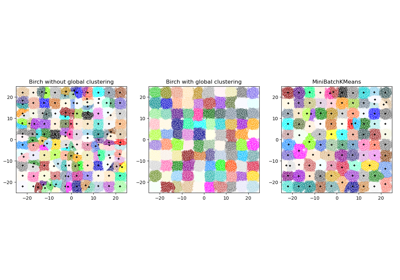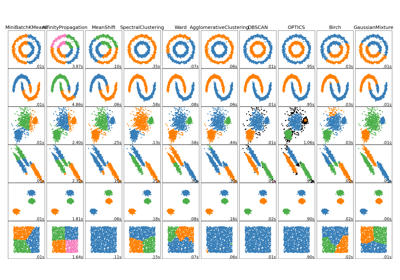sklearn.cluster.Birch¶
-
class
sklearn.cluster.Birch(*, threshold=0.5, branching_factor=50, n_clusters=3, compute_labels=True, copy=True)[source]¶ Implements the Birch clustering algorithm.
It is a memory-efficient, online-learning algorithm provided as an alternative to
MiniBatchKMeans. It constructs a tree data structure with the cluster centroids being read off the leaf. These can be either the final cluster centroids or can be provided as input to another clustering algorithm such asAgglomerativeClustering.Read more in the User Guide.
New in version 0.16.
- Parameters
- thresholdfloat, default=0.5
The radius of the subcluster obtained by merging a new sample and the closest subcluster should be lesser than the threshold. Otherwise a new subcluster is started. Setting this value to be very low promotes splitting and vice-versa.
- branching_factorint, default=50
Maximum number of CF subclusters in each node. If a new samples enters such that the number of subclusters exceed the branching_factor then that node is split into two nodes with the subclusters redistributed in each. The parent subcluster of that node is removed and two new subclusters are added as parents of the 2 split nodes.
- n_clustersint, instance of sklearn.cluster model, default=3
Number of clusters after the final clustering step, which treats the subclusters from the leaves as new samples.
None: the final clustering step is not performed and the subclusters are returned as they are.sklearn.clusterEstimator : If a model is provided, the model is fit treating the subclusters as new samples and the initial data is mapped to the label of the closest subcluster.int: the model fit isAgglomerativeClusteringwithn_clustersset to be equal to the int.
- compute_labelsbool, default=True
Whether or not to compute labels for each fit.
- copybool, default=True
Whether or not to make a copy of the given data. If set to False, the initial data will be overwritten.
- Attributes
- root__CFNode
Root of the CFTree.
- dummy_leaf__CFNode
Start pointer to all the leaves.
- subcluster_centers_ndarray
Centroids of all subclusters read directly from the leaves.
- subcluster_labels_ndarray
Labels assigned to the centroids of the subclusters after they are clustered globally.
- labels_ndarray of shape (n_samples,)
Array of labels assigned to the input data. if partial_fit is used instead of fit, they are assigned to the last batch of data.
See also
MiniBatchKMeansAlternative implementation that does incremental updates of the centers’ positions using mini-batches.
Notes
The tree data structure consists of nodes with each node consisting of a number of subclusters. The maximum number of subclusters in a node is determined by the branching factor. Each subcluster maintains a linear sum, squared sum and the number of samples in that subcluster. In addition, each subcluster can also have a node as its child, if the subcluster is not a member of a leaf node.
For a new point entering the root, it is merged with the subcluster closest to it and the linear sum, squared sum and the number of samples of that subcluster are updated. This is done recursively till the properties of the leaf node are updated.
References
Tian Zhang, Raghu Ramakrishnan, Maron Livny BIRCH: An efficient data clustering method for large databases. https://www.cs.sfu.ca/CourseCentral/459/han/papers/zhang96.pdf
Roberto Perdisci JBirch - Java implementation of BIRCH clustering algorithm https://code.google.com/archive/p/jbirch
Examples
>>> from sklearn.cluster import Birch >>> X = [[0, 1], [0.3, 1], [-0.3, 1], [0, -1], [0.3, -1], [-0.3, -1]] >>> brc = Birch(n_clusters=None) >>> brc.fit(X) Birch(n_clusters=None) >>> brc.predict(X) array([0, 0, 0, 1, 1, 1])
Methods
fit(X[, y])Build a CF Tree for the input data.
fit_predict(X[, y])Perform clustering on X and returns cluster labels.
fit_transform(X[, y])Fit to data, then transform it.
get_params([deep])Get parameters for this estimator.
partial_fit([X, y])Online learning.
predict(X)Predict data using the
centroids_of subclusters.set_params(**params)Set the parameters of this estimator.
transform(X)Transform X into subcluster centroids dimension.
-
__init__(*, threshold=0.5, branching_factor=50, n_clusters=3, compute_labels=True, copy=True)[source]¶ Initialize self. See help(type(self)) for accurate signature.
-
fit(X, y=None)[source]¶ Build a CF Tree for the input data.
- Parameters
- X{array-like, sparse matrix} of shape (n_samples, n_features)
Input data.
- yIgnored
Not used, present here for API consistency by convention.
- Returns
- self
Fitted estimator.
-
fit_predict(X, y=None)[source]¶ Perform clustering on X and returns cluster labels.
- Parameters
- Xarray-like of shape (n_samples, n_features)
Input data.
- yIgnored
Not used, present for API consistency by convention.
- Returns
- labelsndarray of shape (n_samples,)
Cluster labels.
-
fit_transform(X, y=None, **fit_params)[source]¶ Fit to data, then transform it.
Fits transformer to X and y with optional parameters fit_params and returns a transformed version of X.
- Parameters
- X{array-like, sparse matrix, dataframe} of shape (n_samples, n_features)
- yndarray of shape (n_samples,), default=None
Target values.
- **fit_paramsdict
Additional fit parameters.
- Returns
- X_newndarray array of shape (n_samples, n_features_new)
Transformed array.
-
get_params(deep=True)[source]¶ Get parameters for this estimator.
- Parameters
- deepbool, default=True
If True, will return the parameters for this estimator and contained subobjects that are estimators.
- Returns
- paramsmapping of string to any
Parameter names mapped to their values.
-
partial_fit(X=None, y=None)[source]¶ Online learning. Prevents rebuilding of CFTree from scratch.
- Parameters
- X{array-like, sparse matrix} of shape (n_samples, n_features), default=None
Input data. If X is not provided, only the global clustering step is done.
- yIgnored
Not used, present here for API consistency by convention.
- Returns
- self
Fitted estimator.
-
predict(X)[source]¶ Predict data using the
centroids_of subclusters.Avoid computation of the row norms of X.
- Parameters
- X{array-like, sparse matrix} of shape (n_samples, n_features)
Input data.
- Returns
- labelsndarray of shape(n_samples,)
Labelled data.
-
set_params(**params)[source]¶ Set the parameters of this estimator.
The method works on simple estimators as well as on nested objects (such as pipelines). The latter have parameters of the form
<component>__<parameter>so that it’s possible to update each component of a nested object.- Parameters
- **paramsdict
Estimator parameters.
- Returns
- selfobject
Estimator instance.
-
transform(X)[source]¶ Transform X into subcluster centroids dimension.
Each dimension represents the distance from the sample point to each cluster centroid.
- Parameters
- X{array-like, sparse matrix} of shape (n_samples, n_features)
Input data.
- Returns
- X_trans{array-like, sparse matrix} of shape (n_samples, n_clusters)
Transformed data.


